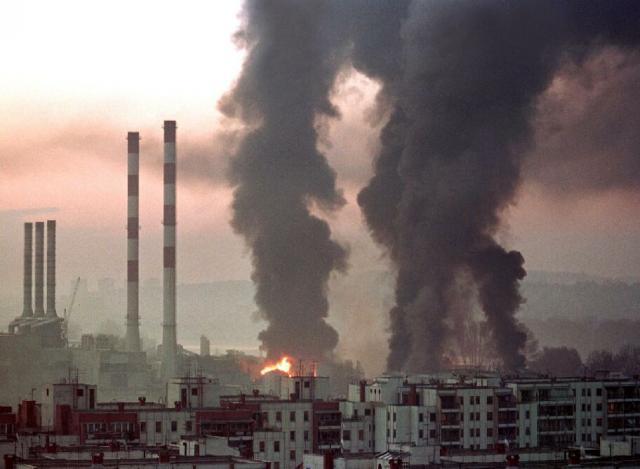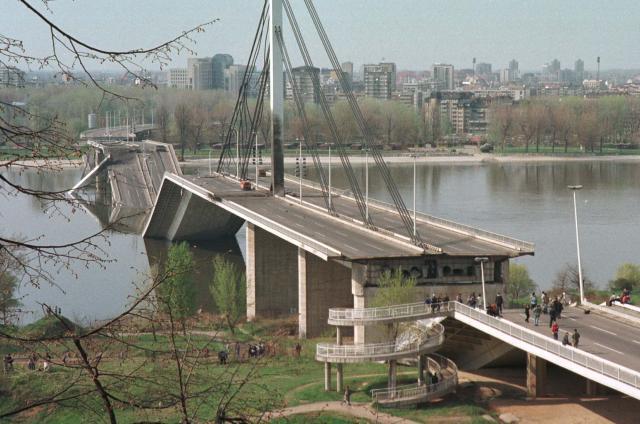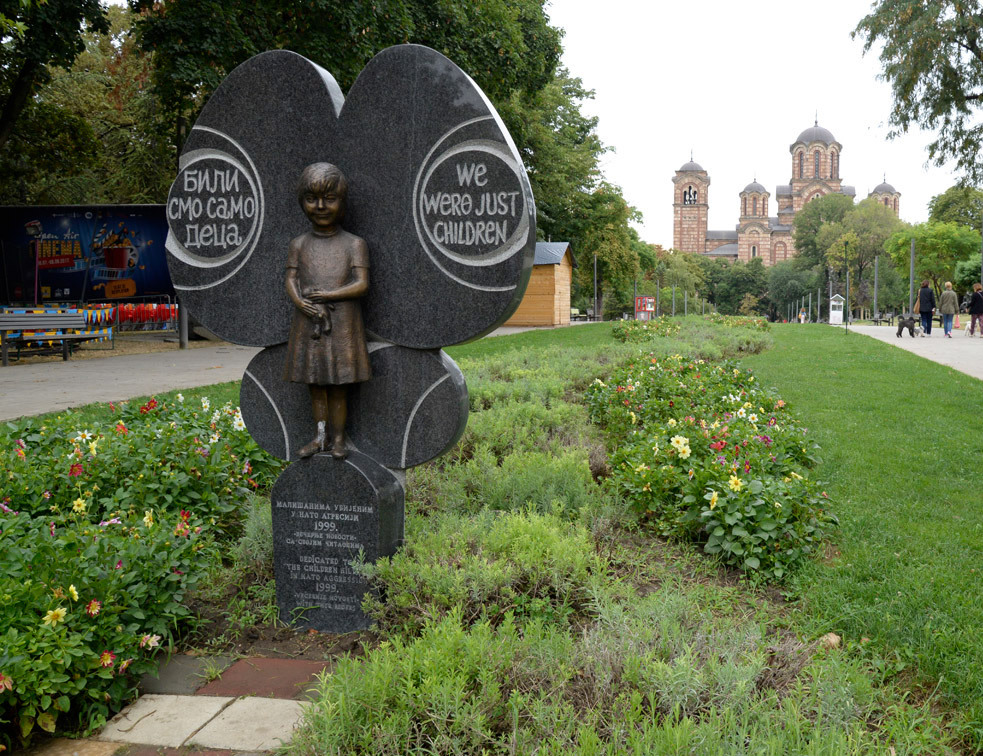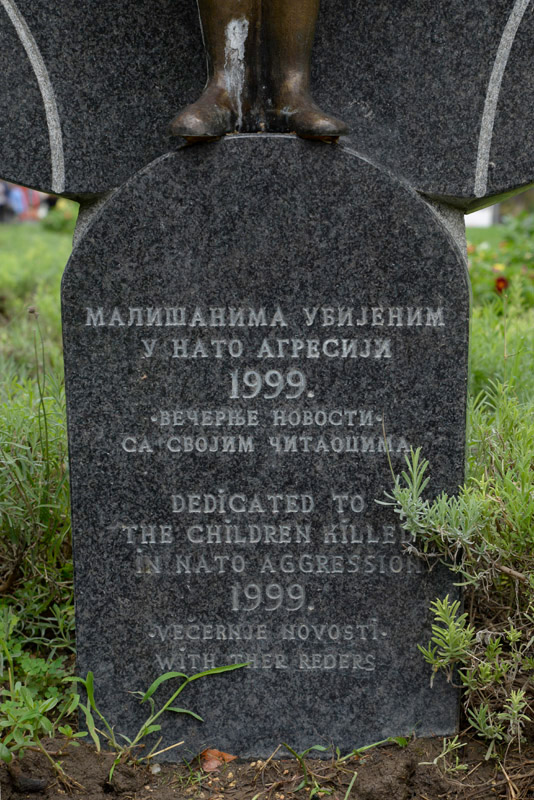|
- Press Release, Ad-Hoc Committee to Stop Canada's Participation in the
War in Yugoslavia, April 11, 1999 -
Amply documented, the bombings of Yugoslavia are not strictly aimed at military and strategic targets as claimed by NATO. They are largely intent on destroying the country's
civilian infrastructure as well as its institutions.
According to Yugoslav sources, NATO has engaged around 600
aeroplanes of which more than 400 are combat planes. They have flown almost 3,000 attack sorties, "with 200 in one night alone against 150 designated targets." They have dropped thousands of tons of explosives and have launched some 450 cruise
missiles.
The intensity of the bombing using the most advanced military
technology is unprecedented in modern history. It far surpasses the bombing raids of World War II or the Vietnam War.
The bombings have not only been directed against industrial
plants, airports, electricity and telecommunications facilities, railways, bridges and fuel depots They have also targeted
schools, health clinics, day care centres, government buildings, churches, museums, monasteries and historical landmarks.
Infrastructure and Industry
 
Left: heating plant in Belgrade bombed by NATO; right: a bombed bridge
in Novi Sad.
According
to Yugoslav sources: "road and railway networks, especially road and rail bridges, most of which were destroyed or damaged beyond repair, suffered extensive destruction." Several thousand
industrial facilities have been destroyed or damaged with the consequence of paralysing the production of consumer goods. According to Yugoslav sources, "By totally destroying business facilities across the country, 500,000 workers were left jobless, and 2 million citizens without any source of income and
possibility to ensure minimum living conditions." Western
estimates as to the destruction of property in Yugoslavia stand at more than U.S.$100 billion.
Bombing of Urban and Rural Residential Areas
Villages with no visible military or strategic structures have been bombed. Described as "collateral damage," residential areas in all major cities. The downtown area of Pristina (which includes apartment buildings and private
dwellings) has been destroyed. Central-downtown Belgrade -- including government buildings -- have been hit with cluster bombs and there are massive flames emanating from the
destruction. According to the International Center for Peace and Justice (ICPJ): "No city or town in Yugoslavia is being spared. There are untold civilian casualties. The beautiful capital city of Belgrade is in flames and fumes from a destroyed chemical plant are making it necessary to use gas masks."
Civilian Casualties
Both the
Yugoslavia authorities and NATO have downplayed the number of civilian casualties. The evidence amply confirms that NATO has created a humanitarian catastrophe. The bombings are largely responsible for driving people from their homes. The bombings have killed people regardless of their nationality or religion. In Kosovo, civilian casualties affect all ethnic groups.
According to a report of the Decany Monastery in Kosovo received in the first week of the bombing:
"Last night a cruise missile hit the old town in Djakovica,
mostly inhabited by Albanians, and made a great fire in which several Albanian houses were destroyed ..." In short, NATO attacks are nothing but barbarous aggression which affects mostly the innocent civilian population, both Serb and Albanian.  
Memorial to the children killed by NATO's aggression against Yugoslavia,
Tasmajdan Park, Belgrade, Serbia.
The Dangers of Environmental Contamination
Refineries and warehouses storing liquid raw materials and chemicals have been hit causing environmental contamination. The latter have massively exposed the civilian population to the emission of poisonous gases. NATO (with its) air strikes on the chemical industry is intent on creating an environmental disaster, "which is something not even Adolf Hitler did during World War II." According to the Serbian Minister for Environmental Protection, Branislav Blazic, "the aggressors were lying when they said they would hit only military targets and would observe international conventions, because they are using illegal weapons such as cluster bombs, attacking civilian targets and trying to provoke an environmental disaster." A report by NBC TV confirms that NATO has bombed the pharmaceutical complex of Galenika, the largest medicine factory in Yugoslavia located in the suburbs of Belgrade. The fumes from this explosion have serious environmental implications. ... The supply of drinking water to the inhabitants of Belgrade is also getting difficult after the drinking water facility at Zarkovo was bombed.
Hospitals and Schools
NATO has
targeted many hospitals and health care institutions, which have been partially damaged or totally destroyed. These include 13 of the country's major hospitals. More than 150 schools (including pre-primary day care centres) have been damaged or destroyed. According to Yugoslav sources, more than 800,000 pupils and students do not attend schools in the wake of the war
destruction. There are almost no pre-school institutions
(nurseries and day-care centres) which are operational.
Churches, Monasteries and Historical
Landmarks
NATO has also systematically targeted
churches, monasteries, museums, public monuments and historical landmarks.
"The targets of the attacks on historical and cultural landmarks have included the Gracanica monastery, dating back to the 14th century, the Pec Patriarchate (13th century), the Rakovica monastery and the Petrovarardin Fortress, which are testimony to the foundations of the European civilization, are in all world encyclopedias and on the UNESCO World Heritage
list."
The Use of Weapons Banned by International Convention
The NATO bombings have also used weapons
banned by international convention. Amply documented by
scientific reports, the cruise missiles utilize depleted uranium "highly toxic to humans, both chemically as a heavy metal and radiologically as an alpha particle emitter." Since the Gulf War, depleted uranium (DU) has been substituted for lead in bullets and missiles. According to scientists "it is most likely a major contributor to the Gulf War Syndrome experienced both by the veterans and the people of Iraq." According to radiobiologist Dr. Rosalie Bertell, president of the International Institute of Concern for Public Health:
"When used in war, the depleted uranium (DU) bursts into
flame [and] releases a deadly radioactive aerosol of uranium, unlike anything seen before. It can kill everyone in a tank. This ceramic aerosol is much lighter than uranium dust. It can travel in air tens of kilometres from the point of release, or be stirred up in dust and resuspended in air with wind or human movement. It is very small and can be breathed in by anyone: a baby, pregnant woman, the elderly, the sick. This radioactive ceramic can stay deep in the lungs for years, irradiating the tissue with powerful alpha particles within about a 30 micron sphere, causing emphysema and/or fibrosis. The ceramic can also be swallowed and do damage to the gastro-intestinal tract. In time, it penetrates the lung tissue and enters into the blood stream. ... It can also initiate cancer or promote cancers which have been initiated by other carcinogens."
According to Paul Sullivan, executive director of the National Gulf War Resource Center:
"In Yugoslavia, it's expected that depleted uranium will be
fired in agricultural areas, places where livestock graze and where crops are grown, thereby introducing the spectre of
possible contamination of the food chain."
The New York based International Action Center called the
Pentagon's decision to use the A-10 "Warthog" jets against targets in Serbia "a danger to the people and environment of the entire Balkans." (Truth in Media, April 10, 1999). In this regard, a report in from Greece "registered an increase in levels of toxic substances in the atmosphere of Greece, and said that Albania, Macedonia, Italy, Austria and Hungary all face a
potential threat to human health as a result of NATO's bombing of Serbia, which includes the use of radioactive depleted uranium shells." (See Truth in Media, April 10, 1999).
The Plight of the Refugees
What is
not conveyed by the international media, is that people of all ethnic origins including ethnic Albanians, Serbs and other ethnic groups are leaving Kosovo largely as a result of the bombing. There are reports that ethnic Albanians have left Kosovo for
Belgrade where they have relatives. There are 100,000 ethnic Albanians in Belgrade. The press has confirmed movements of ethnic Albanians to Montenegro. Montenegro has been portrayed as a separate country, as a safe-haven against the Serbs. The fact of the matter is that Montenegro is part of Yugoslavia.
(TML Weekly, Supplement No. 9 - March 16, 2019)
Return to Index on Ukraine
(To access articles individually click on
the black headline.)
Website: www.cpcml.ca
Email: editor@cpcml.ca
|